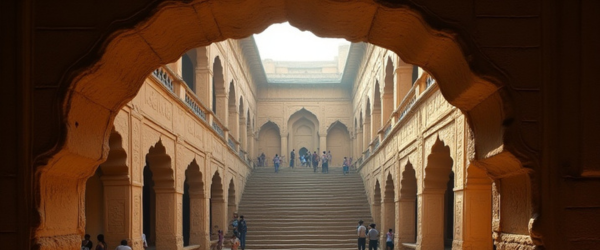Who Built Rani Ki Vav? Uncovering the Queen’s Subterranean Masterpiece in Gujarat

A Mesmerizing Step into India’s Artistic and Architectural Legacy
India’s heritage is filled with grand forts, ornate temples, and regal palaces—but some of its most remarkable marvels lie not above the ground, but beneath it. One such hidden gem is Rani Ki Vav, the awe-inspiring stepwell nestled in Patan, Gujarat.
This isn’t just another heritage site—it’s an immersive descent into a world where every step reveals myth, meaning, and masterful art. A symbol of devotion, design, and deep historical insight, Rani Ki Vav holds a unique position in India’s architectural legacy.
Who Built Rani Ki Vav? A Queen’s Monument of Love
Rani Ki Vav was constructed in the 11th century by Queen Udayamati, wife of King Bhima I of the Solanki (Chaulukya) dynasty. This architectural marvel wasn’t built merely as a water reservoir but as a memorial in honor of her late husband.
It is more than a token of mourning—it is a celebration of craftsmanship, of divine symbolism, and of the profound cultural reverence for water. The queen’s tribute was etched not in verse or stone plaques, but in a grand subterranean structure that continues to speak of elegance and excellence centuries later.
A Masterpiece of Maru-Gurjara Architecture
Constructed using sandstone, the stepwell is a stunning example of Maru-Gurjara architecture—a style celebrated for its precision and ornate detailing. Oriented along a north-south axis, the stepwell stretches 64 meters in length, spans 20 meters in width, and reaches down 27 meters into the earth.
Rani Ki Vav is built across seven levels of steps, each adorned with elaborately carved side panels, corridors, and pavilions. As you descend these levels, the space transforms from a utilitarian well to a sacred, almost meditative, sanctum.
Sculptural Grandeur: More Than Just Decoration
One of Rani Ki Vav’s most extraordinary features is its over 1,500 intricately carved sculptures. These are not ornamental—they are narratives in stone. From panels depicting Vishnu’s avatars to celestial dancers, yoginis, and apsaras, every figure contributes to a visual story of life, divinity, and cosmic balance.
Even the minutest details—ornaments, facial expressions, gestures—have been masterfully rendered. Themes from the Ramayana, Mahabharata, and other Hindu epics are embedded across the structure, bringing mythology into architectural reality.
What’s especially notable is the prominence of feminine divinity. Goddesses, apsaras, and serpent maidens highlight the sacred feminine, revealing how the monument also honors womanhood through spiritual symbolism.
Water as Divinity and Design
Stepwells like Rani Ki Vav were more than engineering feats—they embodied spirituality, sustainability, and community care. Water, considered a purifier and life force in Indian tradition, was accessed through these grand structures as a ritualistic act.
Descending into Rani Ki Vav isn’t just a physical experience—it mirrors a spiritual journey, inviting reflection, reverence, and inner stillness. Each level guides the visitor closer to the earth’s heart, emphasizing rebirth and regeneration—a deeply symbolic gesture in Indian cosmology.
Rediscovered and Reclaimed
For centuries, the stepwell lay buried under layers of silt, its beauty hidden following floods from the nearby Saraswati River. It wasn’t until the late 1980s that the Archaeological Survey of India (ASI) fully excavated and restored this hidden treasure.
In 2014, Rani Ki Vav was declared a UNESCO World Heritage Site, and in 2016, it won the title of “Most Clean and Iconic Tourist Place” in India. Today, it stands not only as an archaeological marvel but as a symbol of India’s continued effort to preserve its heritage.
Why Rani Ki Vav Still Matters
Emerging from Rani Ki Vav, one doesn’t just feel like a tourist. The site impresses upon every visitor a sense of timelessness. It tells us about a time when monuments weren’t built for vanity, but for memory—and when architecture was both devotional and environmental.
The fact that this monumental work was commissioned by a queen speaks volumes about the roles women played in shaping the narrative and built legacy of India. It’s a heritage of leadership, love, and legacy—written not in books but in carved stone.
Travel Tip: When & How to Visit
If you’re planning a trip to Gujarat, Rani Ki Vav is best visited during the early morning or golden hour to experience the changing light on the sandstone carvings. The cooler temperatures also make the descent more comfortable. Consider pairing it with visits to nearby attractions like Modhera Sun Temple for a deeper dive into Solanki-era brilliance.










